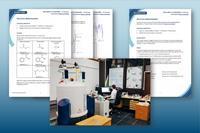Test learners’ ability to suggest chemical structures based on spectral evidence by asking them to match the skeletal structures in the student worksheet to the sets of infrared, 13C and 1H NMR spectra
This resource accompanies the Education in Chemistry article How to teach structure determination.
Learning objectives
- Apply an understanding of infrared, 13C NMR and 1H NMR spectra.
- Identify the spectra of given compounds.
Teacher notes
If learners struggle to get started with this activity, encourage them to pick one molecule and identify key features they would expect to see in the spectra such as:
- Strong absorbances (C=O, O-H) in the infrared spectra.
- Number of peaks in the 13C NMR spectrum and approximate chemical shifts.
This will enable learners to narrow down the number of possible matches before looking at the now reduced number of spectra in more detail.
Full interpretation of spectra is not necessary to complete the activity but would provide a suitable challenge and help students develop mastery in structure determination.
More resources
- Practice interpreting 1H and 13C NMR, mass spectra, and thin layer chromatograms with these structure determination Starter for ten questions.
- Find out how a scientific associate uses NMR to identify the structure of new and unknown chemical compounds to support the development of new medicines.
- Watch this practical video to link structure determination to testing for organic functional groups.
Downloads
Structure determination student worksheet
Handout | PDF, Size 1.49 mbStructure determination teacher notes
Handout | PDF, Size 0.13 mbStructure determination student worksheet
Editable handout | Word, Size 2.05 mbStructure determination teacher notes
Editable handout | Word, Size 0.44 mb



















No comments yet